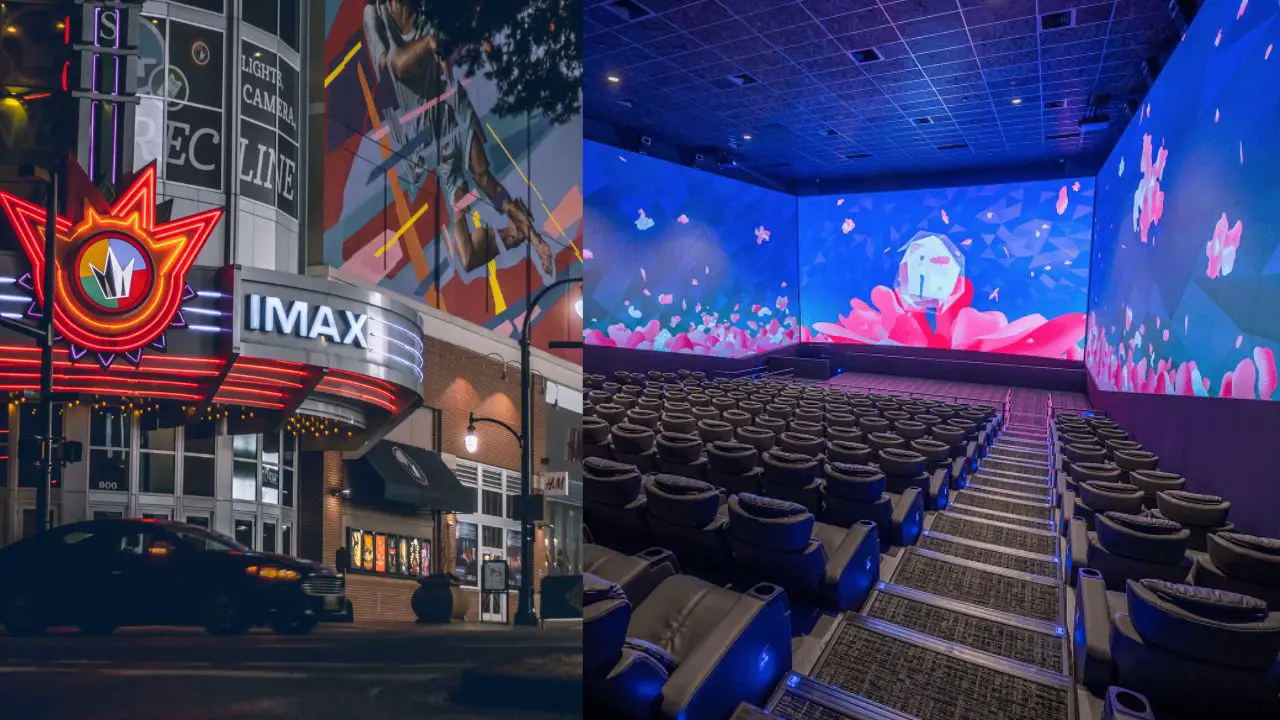In our swiftly evolving world, cinema isn’t far behind, continuously transforming and introducing innovative formats. Among these groundbreaking technologies, ScreenX and IMAX stand out. While IMAX has long been recognized for its massive screens, ScreenX is a fresher face on the scene, leading many to wonder how it stacks up against its more established counterpart. Dive into our guide where we juxtapose IMAX with standard cinemas to discern the nuances between them.
Which One’s Better: Screenx vs IMAX
| Aspect | ScreenX | IMAX |
|---|---|---|
| Screen Size | 270-degree Panoramic Screen | 72 feet tall and 52 feet wide |
| Aspect Ratio | 1:1.5 – 1:2.0 | 1.43:1 – 1.90:1 |
| Sound System | 7.1 surround sound system | 12-channels based surround sound system |
| Projection | It uses three cameras for film production | 70mm film system, Dual digital projection, and linear polarization. |
| Seating | 300 seats: Executive, Premier, Silver | 100-250 seats |
| Price | $15-$20 | $18-$24 |
| Availability | 364 Screens in 37 Countries | 1700 Screens in 80 Countries |
Quick Answer: At a glance, IMAX is a better option as it has more media availability across the globe, has more variety of films to show, a gigantic screen size, and an immersive audio experience to complement cutting-edge projection and visuals. The price is a little higher but worth the hype.
Let’s look into the features of both these cinema formats to understand better which suits you. The choice of cinema format depends on multiple factors, so one size doesn’t fit all.
Comparing the Features: ScreenX Vs. IMAX
Screen Size and Aspect Ratio:
| Aspect | ScreenX | IMAX |
|---|---|---|
| Screen Size | It depends on the theater’s architecture | 72 feet tall, 52 feet wide |
| Aspect Ratio | 1:1.5- 1:2.0 | 1.43:1- 1.90:1 |
| Screen projection | 270 degrees panoramic screen. | One Giant screen at the front. |
The screen size is the first important feature between the two cinema formats. IMAX has a stellar reputation for its massive screens, which cover the whole wall from top to bottom. This gigantic screen creates an immersive watching experience. The aspect ratio of IMAX, i.e., 1.43:1, means that for every 1.43 units of width, there is one unit of height.
On the other hand, ScreenX uses a different strategy for film display. Instead of using one giant screen, they project screens on the front and sides of the cinema walls, which creates a panoramic effect, engulfing the viewer from every side of the cinema.
Sound System:
| Aspect | ScreenX | IMAX |
|---|---|---|
| Sound System | 7.1 Surround Sound | 12 Channels-based Surround Sound System |
| Placement | Traditional | Advanced Speaker Placement |
| Audio Technology | Industry-standard surround sound | Proprietary audio technology |
| Sound Precision | Sound aligned with side screens | Precisely calibrated. |
IMAX cinema uses an uncompressed audio system, i.e., a 12-channel surround sound system, to see how this compares with another top-tier audio experience, check out our article on IMAX vs Dolby Cinema. to complement the gigantic screen. Some IMAX cinemas also incorporate Dolby audio formats, including Dolby Atmos; however, this may vary from one IMAX cinema to another.
ScreenX, on the other hand, uses a standard 7.1 surround sound system for an immersive listening experience. However, the sound system is less immersive than the IMAX cinemas.
Projection Technology:
Image projection has a crucial role in image and video quality, for which IMAX uses large format projection systems, including dual digital polarization for image projection.
In addition, IMAX movies are shot using specialized cameras to fit the large screen format. The film shooting process uses a 70mm film camera, increasing the projection’s size. The actual filmmakers do This recording process instead of a third party.
On the other hand, ScreenX uses a multi-projection system to provide 270-degree panoramic projection, which surrounds the viewer from every side of the cinema. This is obtained by strategically placing multiple projectors in the cinema, synchronized to provide a seamless visual experience across all the screens.
There are three steps to play a movie for ScreenX cinema.
- Pre-Production Planning: Filmmakers consider the ScreenX format before film production and plan for shots that utilize expanded visual space on the sidewalls of the theater.
- Camera Setup and Filming: This is done during the filming process, where special camera steps and techniques are used to frame shots for a multi-screen environment. Filmmakers use three cameras to capture content for central and additional side screens.
- Post-Production Editing: This is done after the movie is recorded. Filmmakers edit the movie for central/ primary and secondary/side screens through editing software. They also add visual effects, enhance the background and extra shots, and calibrate the content for a seamless transition for the side screens to create an immersive experience.
So, here the winner is decided on personal preferences. If you’re looking for larger screens with surreal visuals, IMAX is the one for you. However, if you’re looking for an immersive watching experience where you feel right in the middle of the movie, ScreenX takes the lead by providing 270-degree screen projection.
Seating and Comfort:
IMAX cinema provides a comfortable watching experience with its well-padded, plush, and spacious seats. If you’re looking for the ideal viewing spot in an IMAX theater, don’t miss our guide on selecting the Best Seat for IMAX. There are about 100-250 seats in one IMAX cinema; however, the number of seats may vary from one location to another.
You must note that the front seats at the IMAX cinema are too close to the screen and can make you uncomfortable. The viewer might have to tilt their head or bend his spine during the movie, which can get quite uncomfortable.
On the other hand, the ScreenX cinema has about 300 seats divided into three sections, i.e., Executive, premier, and Silver, from the closest to farthest, respectively. The seats are quite comfortable. However, the viewer might sometimes get distracted because of the extended side screens.
Availability:
Since IMAX has been in action far before ScreenX, it has a better global appearance than its competitor. There are a total of 1700 IMAX cinemas in about 80 countries across the globe. Furthermore, it has a wide variety of movies for viewers, including movies from major movie production companies, i.e., Warner Bros. Pictures, Universal, Paramount, Columbia Pictures, Dreamwork Animation, and Walt Disney movies.
Some famous movies in the IMAX cinema include Doctor Strange in the Multiverse of Madness, Fall, Spiderman, The Marvels, Dune: Part Two, Mission Impossible, and Oppenheimer.
On the other hand, the global appearance of ScreenX cinemas is quite limited, with a total of 364 screens in 37 countries. Furthermore, it has a limited number of movies available. As these movies require being shot with three cameras, only a limited number are recorded in this format. Some latest movies in ScreenX format include Shazam Fury of Gods, Guardians of Galaxy 3, Thor: Love and Thunder, and Fantastic Beasts: The Secrets of Dumbledore.
So, you’re more likely to find an IMAX cinema in your surrounding than ScreenX.
Price:
The price of IMAX cinema tickets is more than the ScreenX format. You can get a movie ticket for the IMAX cinema for about $18-$24. On the other hand, the ticket for the same movie for ScreenX could range from $15-$20. So, you may choose one that fits your budget.
What Moviegoers Say About IMAX and ScreenX
In recent times, both IMAX and ScreenX have attracted significant attention for the unique cinematic experiences they offer. But what do actual moviegoers think about these formats? Based on various discussions, here’s a breakdown of what some viewers have to say:
ScreenX
- Prospective Appeal: Many viewers were intrigued by the ScreenX’s 270-degree panoramic experience, expecting an immersive experience, especially with movies that feature vast landscapes or dynamic action sequences.
- Unpredictable Impact: Some users found the ScreenX format engaging, particularly for movies with expansive sets or action sequences. They felt the peripheral visuals added depth to certain scenes and made them feel more “inside” the movie.
- Distractive at Times: However, a significant number of users felt that the side visuals could be distracting, especially when they didn’t sync perfectly with the main screen. They felt that while it could be good for specific movies, it wasn’t consistently beneficial across all films.
- Quality Concerns: Some users noted that the side visuals in ScreenX sometimes appeared of lower quality, and the projection on the side walls could distort colors or appear more faded.
- Price Point: The additional cost for ScreenX was a point of contention for some, with a few suggesting it might not be worth the premium price.
IMAX
- Consistent Quality: Most users recognized IMAX as a premium viewing experience, praising its consistent high quality, larger screens, powerful audio, and the expanded aspect ratios for certain films.
- True Immersion: Moviegoers frequently mentioned that IMAX provides a more consistently immersive experience without the distractions they sometimes encountered with ScreenX.
- Aspect Ratio Variability: Some users noted that not all IMAX movies take full advantage of the expanded aspect ratios, but when they do, it significantly enhances the viewing experience.
- Preference for Authentic IMAX: There was a clear preference for true IMAX theaters, with users noting the difference in experience between authentic IMAX and smaller, “fake” IMAX screens.
Overall:
- Dependent on Movie Choice: Both IMAX and ScreenX seem to be formats that can greatly enhance or detract from a movie, depending on the film in question. Movies with vast landscapes, high-octane action sequences, or other immersive elements can benefit from these formats.
- Personal Preference: Ultimately, whether one prefers IMAX or ScreenX often comes down to individual taste. While some viewers love the enveloping experience of ScreenX, others find it distracting and prefer the consistent quality and immersion of IMAX.
In conclusion, while both IMAX and ScreenX offer unique cinematic experiences, the best choice may vary depending on the movie and personal preferences. It’s always a good idea to read reviews or ask for recommendations based on specific films before deciding which format to choose.
Final Verdict
When choosing a cinema format, you must consider several factors before deciding. These factors include the availability of cinema format in your locality, availability of movie you want to watch, budget, seating, comfort, and audio-video quality.
You may like ScreenX for its extended screens and immersive watching experience; however, if the ScreenX cinema is not in your locality, or the movie you want to watch is unavailable, you’ll have no choice but to give up the idea of choosing ScreenX cinema.
Now, based on the overall features of the two cinema formats, IMAX is a better choice. But if you’re still wondering, Is IMAX Worth It? Discover more about the unique IMAX experience in our detailed guide.”Although both cinema formats offer unique features, IMAX stands out for its cutting-edge video projection, proprietary sound technology, comfortable watching experience, and availability across the globe.
However, ScreenX, too, has a great future for its revolutionary 270-degree screen, and tickets less expensive than IMAX cinema. Furthermore, if you have a ScreenX cinema in your locality and want to enjoy this 270-degree screen experience with high-quality audio, you can go right for it.

I’m Shaun Conroy, an audiophile & founder of HiFi Audios. Holding a Bachelor’s in Sound Engineering, I bring deep expertise in audio devices and offer insights & recommendations to fellow enthusiasts.





